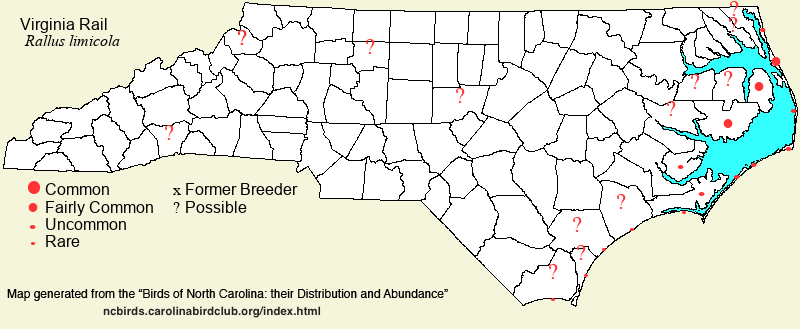 |  |
|
Virginia Rail - Rallus limicola RALLIDAE Members: | Search Common: Search Scientific: |
|
|
|||||||
| General Comments | Only a few decades ago, relatively little was understood of the Virginia Rail's habitats and range in North Carolina, and its breeding status was very unclear. However, the use of tape recordings, and more field work in coastal marshes, has shown that it is locally not uncommon as a breeding bird in some of the northern marshes, and a widespread wintering bird near the coast, as well. Birds migrate through the interior, and a few winter into the edge of the Piedmont. On the other hand, its breeding range away from the coast is very poorly known, with widely scattered and sporadic records from a handful of sites and a few confirmed breeding records, mainly in the mountains. For breeding, Virginia Rails are most numerous in brackish marshes, dominated by black needlerush, but they also occur in fresh marshes to some extent. Wintering birds spread out into more habitats, including wet grasslands, but they are still most numerous in brackish marshes. | ||||||
| Breeding Status | Breeder | ||||||
| NC BRC List | Definitive | ||||||
| State Status | W | ||||||
| U.S. Status | |||||||
| State Rank | S3B,S5N | ||||||
| Global Rank | G5 | ||||||
| Coastal Plain | Permanent resident near the coast, with migratory movements; mostly a transient farther inland. As a breeder -- locally fairly common along the northern coast, south to Carteret, and along the mainland shoreline of Pamlico Sound and tributary rivers; mostly rare to uncommon, and local, along the southern coast and in the Tidewater zone. In winter, fairly common to locally common and more widespread in these same areas. (Numbers seem to be higher in winter than in summer.) Farther inland, mostly a poorly known, probably uncommon migrant in suitable marshes, and rare winter resident, at least locally. Not known to breed well inland. Peak counts: 77, along NC 12 at Cedar Island NWR (Carteret), during high water conditions after the passage of Hurricane Matthew, 9 Oct 2016; 65, Bodie-Pea Is. CBC, 28 Dec 1996; 23, Piney Island, 19 Jun 1992. | ||||||
| Piedmont | Mostly a transient, but scattered summer and winter records, where status at these two seasons is unclear. One conclusive breeding record: a dead chick was found at Winston-Salem (Forsyth) on 23 Apr 2023, where the pair of adults had been seen and heard on several occasions since 13 May [Chat 87:63-64 link]. Rare to locally uncommon transient, but poorly surveyed; mainly Mar to early May, and Aug to early Oct. Possibly bred at Jordan Lake in 1977 and 1980, and near Winston-Salem in 1985. Numerous winter records for the Raleigh area, where a few might overwinter; a few early winter records elsewhere. One apparently overwintered along Howerton Road (Guilford), as it was frequently heard from 11 Dec 2019 into Mar 2020. A daily count of four from 18-23 Oct 2022 west of Apex (Wake) was notable. Peak counts: ?. | ||||||
| Mountains | Poorly known transient (about 21 reports), with two known breeding records, and several reports of possible or probable breeders. Assumed now to be likely breeding at sporadic sites in the region. Very rare to rare but poorly surveyed in spring and fall, at low elevations (below 2,500 feet). Higher elevation reports include one at Craggy Gardens (Buncombe) on 14 May 2006; one at Brookshire Park (Watauga) at 3,000 feet from 29 Oct - 3 Nov 2014; and one at Clawson-Burnley Park (Watauga) from 30 Apr - 10 May 2020. One to two were noted at Flat Rock (Henderson) from 24 Mar - 10 May 2016; could these have been breeding birds? Possibly one of these same birds was seen/heard there from 23 Mar - 21 May 2018, and again there in spring 2024. Conclusive was an unpublished report at Meat Camp Environmental Studies Area north of Boone (Watauga), with MCCESA notes saying “Breeding record from MCCESA beginning on 7/17/2003. Persisted through summer with precocial young (5) seen with parent 8/23/2003”; another MCCESA record is for 14 Jul 2007, possibly suggestive of breeding. Two heard calling in a cattail marsh near Boone (Watauga), at roughly 3,600 feet elevation, from 19 May 2023 into summer were strongly suggestive of breeding; and a recently-fledged juvenile seen there on 23 Jun confirms breeding there. Casual (but increasing) in winter, with five such records -- an individual noted from 1 Jan into Mar 2017 at Charles D. Owen Park (Buncombe); one seen at Flat Rock (Henderson) from 6-28 Jan 2019; one at Jackson Park (Henderson) on 5 Jan 2022; one at Enka Lake (Buncombe) from 21-25 Jan 2022; and one to two at Flat Rock from 6-21 Feb 2024. Mainly Mar to May, and Aug into Nov. Peak counts: 2, Henderson, 3 Apr 2003. | ||||||
| Finding Tips |
The descending grunting call is easily heard in migration and winter in tidewater marshes, especially in brackish marshes such as at Bodie Island and Roanoke Island at dawn and dusk. The rails readily respond to taped calls, and often hand clapping will get them calling. In summer, the "kid-ick, kid-ick" call is most often heard. They can occasionally be seen by looking along the muddy edges of brackish marshes at low tide, or by walking through marshes in an attempt to flush them. However, they are not as easy to see as is a Sora, or a Clapper Rail, and you might have to try to flush a calling bird, as a last resort. *** | ||||||
| Attribution | LeGrand[2025-01-29], LeGrand[2024-08-02], LeGrand[2024-05-09] | ||||||
| NC Map Map depicts all counties with a report (transient or resident) for the species. | Click on county for list of all known species. |
| NC Breeding Season Map Map depicts assumed breeding season abundance for the species. |  |